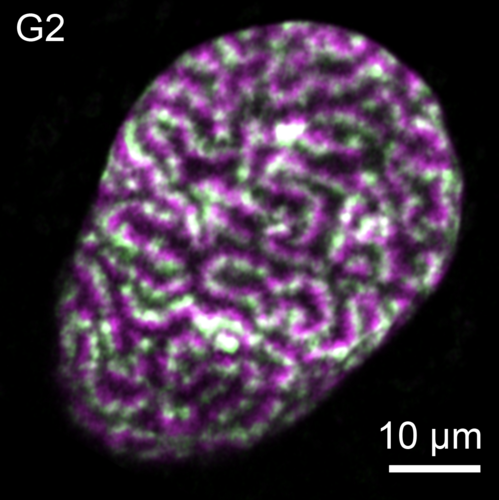A cohesin-regulated tug-of-war inside chromosomes

Human genomic DNA is impressively long, stretching about 10,000 times longer than the diameter of a single cell. At each cell division, this genetic material must be organized such that each daughter cell receives exactly one copy of the genome. Upon replication, the DNA within each chromosome becomes duplicated along a highly folded path, such that the DNA molecules are intricately intertwined. Consequently, the two DNA molecules must be disentangled and packaged into separate bodies, so that they can be moved to daughter cells during cell division. This process, called sister chromatid resolution, was previously attributed to the DNA loop extrusion activity of the condensin complex, which is active only during cell division.
Daniel Gerlich and his team at IMBA now uncovered another important player in this process: a protein complex called cohesin. Cohesin was previously known for connecting the duplicated DNA strands – called sister chromatids – by topological embrace. The team, led by IMBA group leader Daniel Gerlich and the recent Vienna BioCenter PhD Program graduate Paul Batty, found that a specific subset of cohesin complexes helps resolve the tangled sister chromatids via its loop-extruding activity even before cell division.
To understand this process, the researchers developed innovative techniques to visualize the distinct DNA copies in replicated chromosomes. They were also able to manipulate the loop-extrusion activity of cohesin during interphase (the resting phase of the cell cycle) by inactivating certain regulatory factors. This allowed the researchers to control the level of sister chromatid separation, either reducing or increasing the level of separation – even to an extent only normally seen in dividing cells. Even when the researchers depleted condensin – previously thought to be responsible for sister chromatid resolution – they still saw a significant separation of sister chromatids. Thus, the scientists show that sister chromatids resolve by the loop-extruding activity of cohesin, independently of other factors related to mitosis, including condensin.
Cohesin and condensin are part of a family of protein complexes called SMC complexes, which are also found in bacteria and archaea. These organisms do not form microtubule-based spindle filaments that, in eukaryotes, pull chromatids into forming daughter cells. Therefore, scientists had already hypothesized that DNA loop extrusion is the oldest and most universal mechanism for genome segregation in all life forms. The present findings support this hypothesis experimentally by showing that cohesin can fulfill this important role in human cells, even before cell division begins and independently of condensin.